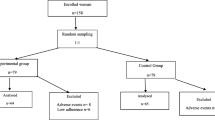Abstract
The objective of this study was to compare the short-term effectiveness of rehabilitation treatment with a standard drug treatment for urge urinary incontinence (UUI). The study design includes parallel clinical trial in an outpatient urogynecologic clinic setting. The subjects were 44 women who suffered from UUI and who were systematically assigned to a rehabilitation group (REH) (N=24) or a medication group (MED) (N=20). The intervention for REH was consisted of five visits during a 3-month period of pelvic floor muscle training and behavioral training, whereas for MED was extended release oxybutynin at 5 mg/day, for 3 months. The urinary symptoms considered were frequency of voiding per day and night (freq/day and freq/night), number of incontinent episodes per week based on a bladder diary, and data based on the Incontinence Quality of Life Instrument (I-QoL). In the within-group comparison, both groups had improved significantly over time with respect to urinary symptoms and I-QoL (p<0.01). In addition, there was a significant group–time interaction effect on freq/day. While REH improved during the 3-month follow-up period, the MED group deteriorated to mean baseline value (p<0.01). A significant negative association was found between the urinary symptoms and the I-QoL at the end of follow-up (r p=−0.35 to −0.62, p<0.05). Three months after the intervention, both groups maintained the achievements of the intervention period. In addition, the REH group demonstrated additional improvement in mean freq/day while the condition of MED patients deteriorated to baseline values.

Similar content being viewed by others
References
Huggins ME, Bhatia NN, Ostergard DR (2003) Urinary incontinence: newer pharmacotherapeutic trends. Obstet Gynecol 15:419–427
Abrams P, Cardozo L, Fall M, Griffiths D, Rosier P, Ulmsten U, Van Kerrebroeck P, Victor A, Wein A (2002) The standardization of terminology of lower urinary tract function: report from the standardisation sub-committee of the International Continence Society (ICS). Am J Obstet Gynecol 187:116–126
Berghmans LCM, Hendriks H, De Bie RA, Van Waalwijk ESC, Van D, BO K, Van Kerrebroeck EV (2000) Conservative treatment of urge urinary incontinence in women: a systematic review of randomized clinical trials. BJU Int 85:254–263
Scoot S (2004) The wet patient: understanding patients with overactive bladder and incontinence. Curr Med Res Opin 20:791–801 (Available at http://medscape)
Van der Vaart CH, De Leeuw JR, Roovers JP, Heints AP (2002) The effect of urinary incontinence and over active bladder symptoms on quality of life in young women. BJU Int 90:544–549
Walters DM (2005) ACOG practice bulletin. Clinical management guidelines for obstetrician–gynecologists, urinary incontinence in women. Obstet Gynecol 105:1533–1545
Sapsford R, Markell S,Bullock-Saxton J (1999) Women’s health. A textbook for physiotherapists. Saunders, London
Haeusler G, Leitich H, van Trotsenburg M, Kaider A, Tempfer CB (2002) Drug therapy of urinary urge incontinence: a systematic review. Obstet Gynecol 100:1003–1016
Gleason DM, Susset J, Wite C, Munoz DR, Sand PK, Ditropan XL, Study Group (1999) Evaluation of a new once-daily formulation of oxybutynin for the treatment of urinary urge incontinene. Urology 3:420–423
Burgio KL, Locher JL, Goode PS, Hardin M, McDowell BJ, Dombrowski M, Candib D (1998) Behavioral vs drug treatment for urge urinary incontinence in older women. A randomized controlled trail. JAMA 280:1995–2000
Khullar V, Hill S, Laval KU, Schiotz HA, Jonas U, Versi E (2004) Treatment of urge predominant mixed urinary incontinence with tolterodine extended release: a randomized, placebo controlled trail. Urology 64 (2):269–274
Patrick DL, Martin ML, Bashnell DM, Yalcin I, Wanger TH, Buesdhing DP (1999) Quality of life of women with urinary incontinence: further development of the incontinence quality of life instrument (I-QOL). Urology 53:71–76
Sapsford R (2004) Rehabilitation of pelvic floor muscles utilizing trunk stabilization. Man Ther 9:3–12
Shafik A, El-Sibai O (2001) Effect of pelvic floor muscle contraction on vesical and rectal function with identification of puborectalis–rectovesical inhibitory reflex and levator–rectovesical excitatory reflex. World J Urol 19:278–284
Prochaska JO, DiClemente CC (1982) Transtheoretical therapy toward a more integrative model of change. Psychotherapy (Chic Ill) 19:276–288 (Available at http://www/education.gov.il/hadracha/gilaion15.hym)
Rodirgues LV, Blander DS, Dorey F, Raz S, Zimmern P (2003) Discrepancy in patient and physician perception of patient’s quality of life related to urinary symptoms. Urology 62:49–53
Stach-Lempinen B, Sintonen H, Kujansuu E (2004) The relationship between clinical parameters and health-related quality of life as measured by the 15D in incontinence women before and after treatment. Acta Obstet Gynecol Scand 83:983–988
Kelleher CJ, Cardozo L, Chapple CR, Haab F, Ridder AM (2005) Improved quality of life in patients with overactive bladder symptoms treated with solifenacin. BJU Int 95:81–85
Homma Y (2002) The clinical significance of the urodynamic investigation in incontinence. BJU Int 90:489–497
DuBeau CE, Khullar V, Versi E (2005) “Unblinding” in randomized controlled drug trials for urinary incontinence: implications for assessing outcomes when adverse effects are evident. Neurourol Urodyn 24:13–20
Author information
Authors and Affiliations
Corresponding author
Additional information
At the time this paper was prepared, Prof. Langer passed away at the age of 57. This paper is therefore in memory of an outstanding physician, mentor and researcher.
Rights and permissions
About this article
Cite this article
Kafri, R., Langer, R., Dvir, Z. et al. Rehabilitation vs drug therapy for urge urinary incontinence: short-term outcome. Int Urogynecol J 18, 407–411 (2007). https://doi.org/10.1007/s00192-006-0163-1
Received:
Accepted:
Published:
Issue Date:
DOI: https://doi.org/10.1007/s00192-006-0163-1




